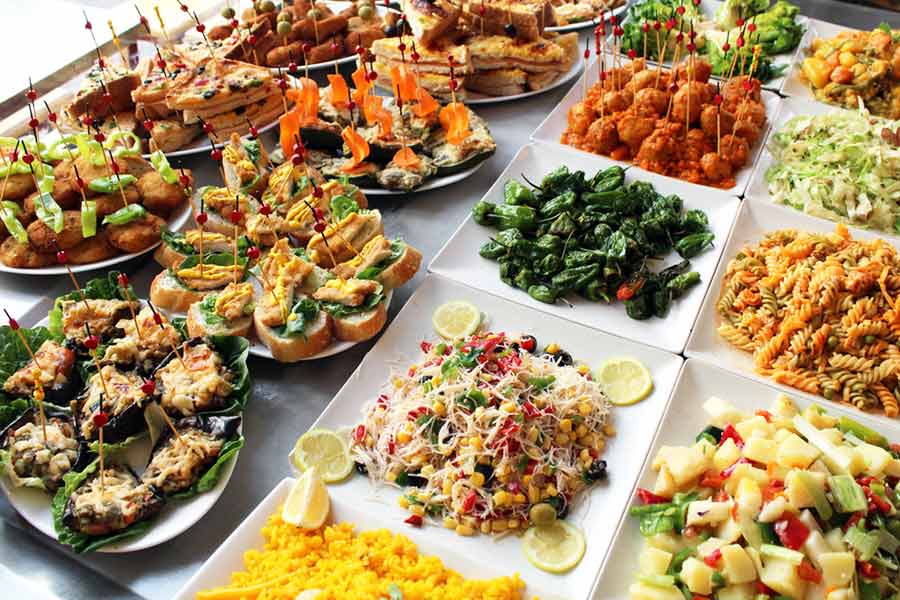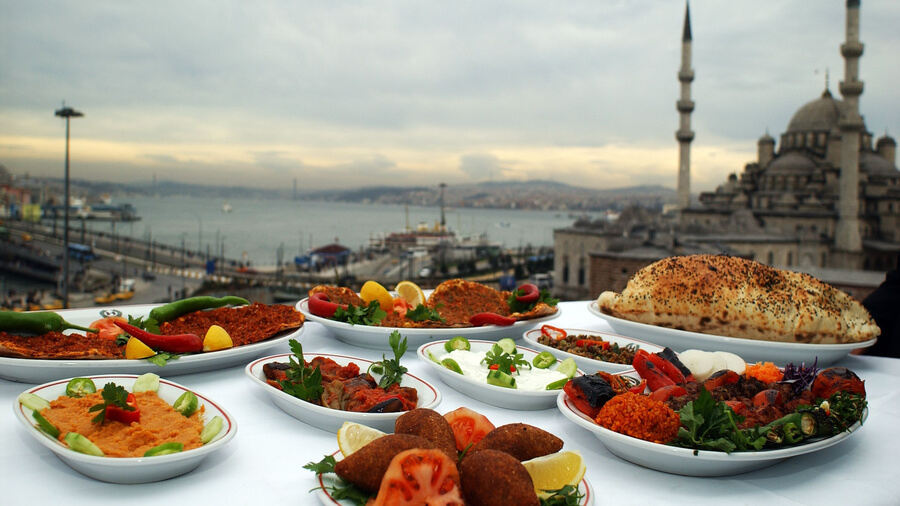Aisles and aisles of local food — charcuteries, cheese and snacks, freshly squeezed fruit juices and cocktails, and piles of fresh produce from sun-kissed tomatoes to asparagus — greet us as we enter the gates with large stained-glass panel at the Atarazanas Food Market in Malaga. We are in Andalusia, an autonomous region on Spain’s southern border, and a melting pot of cultures. Andalusia’s cuisine reflects its history with Christian, Muslim and Jewish influences. The Romans brought in viticulture, and the Berbers and the Moors brought in ingredients like sugarcane, almonds, chickpeas, nuts and oranges, and spices like saffron and cumin.
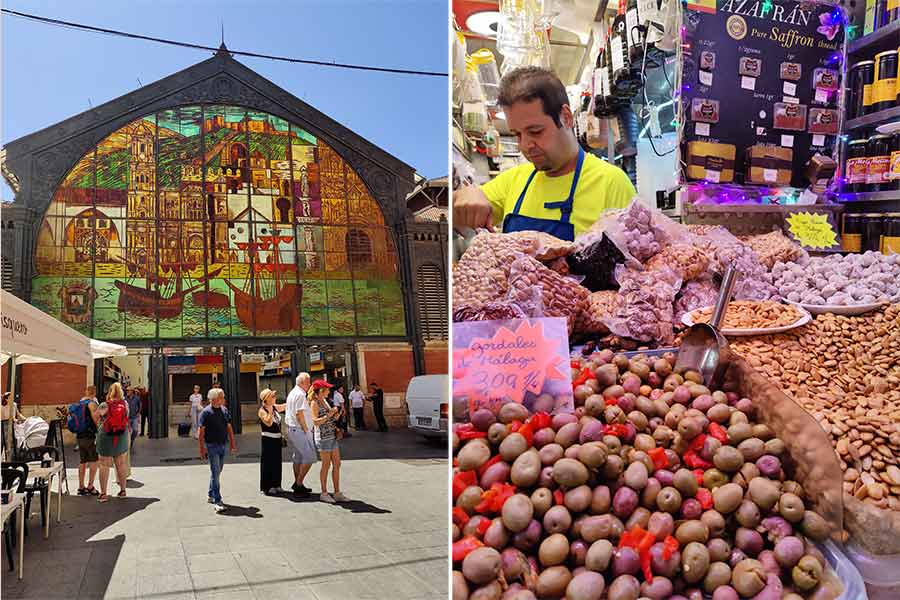
Packed with stalls selling fresh local produce, the The Atarazanas Food Market stands at the site of 14th-century shipyards Kalpana Sunder
Andalusia is also the birthplace of the famous Spanish import, tapas — the little bite-sized snacks served with drinks all over Spain. Interestingly, the story goes that the small portions of tapas originated as a way to control the flies in Seville’s bars! Originally, slices of bread or meat were served covering glasses of sherry in Andalusian taverns, in order to prevent fruit flies from falling into drinks. In time, the taverns noticed that offering that meat had a direct impact on sherry sales and started serving these as snacks.
Our guide, Javier Fernandes Elena, from Spain Food Sherpas, is giving my friends and I a taste of Malaga through a food tour. We go around the market snacking on freshly fried small Padrón peppers, pickled garlic, a variety of olives marinated in spices and herbs, almonds fried in olive oil, slices of the local sheep cheese or Manchego, local Iberian ham, and much more. We sip on refreshing tinto de verano, which is a summer cocktail made with red wine and a lemon soda, topped with lots of ice and garnished with orange and lemon slices. This is what the locals drink — “Sangria is for tourists, ” Javier says with a smile.
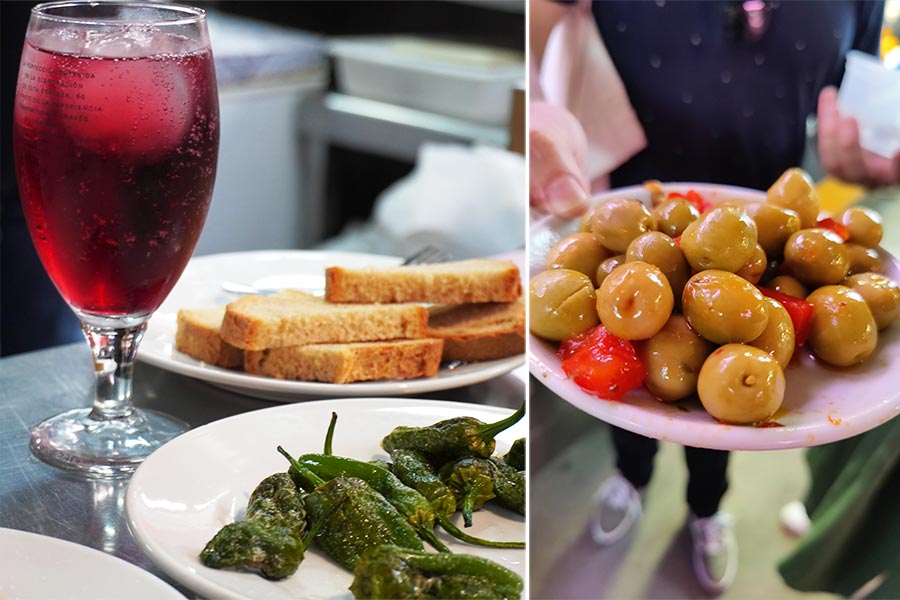
The summery cocktail tinto de verano, fried Padrón peppers and marinated olives are among the staples of a food walk in Malaga Kalpana Sunder
Soupy affairs
In a region like Andalusia, where temperatures soar in the summer, cold dishes like soups are part and parcel of the cuisine. My favourite is the creamy salmorejo, which I learn to make from Chef Matias Vega at his restaurant Alcazaba de las Torres, in the town of Cañete De Las Torres outside Cordoba. The chef is an evangelist in promoting this traditional cold tomato soup, which had its origins in feeding the Roman legions and is still an easy way to feed a large family. He teaches us to make it the conventional way using a mortar and pestle as well as a mixer. The simple ingredients of garlic, extra virgin olive oil, crumbled bread, and tomato are transformed into a velvety soup that is the ultimate comfort food. He serves it with accompaniments like green apple and ham which give it an extra punch.
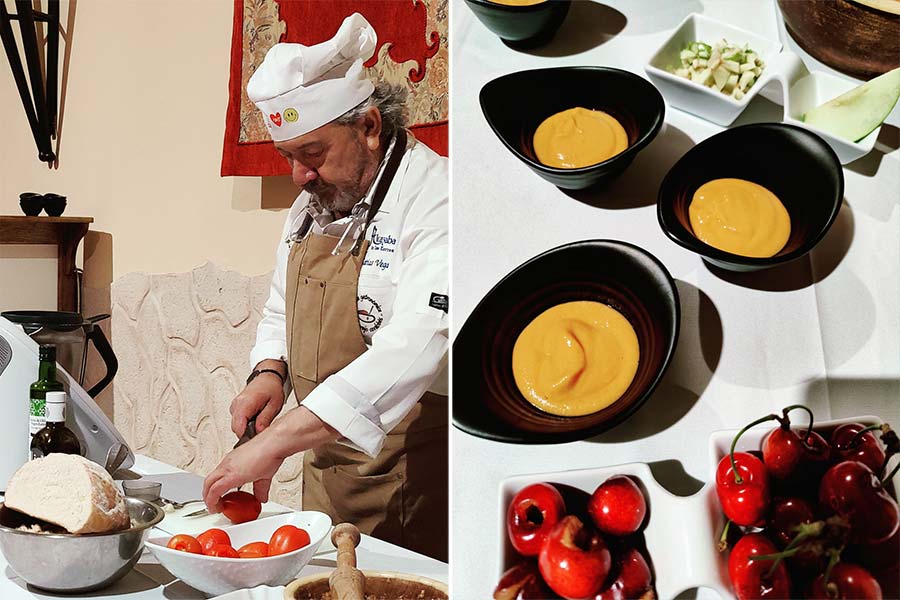
Chef Matias Vega cooking the creamy cold tomato soup, salmorejo Kalpana Sunder
The other cold soup that is an ode to summer freshness is something I am served at a simple lunch prepared in Malaga by La Alacena del Corralon, a cultural association of socially disadvantaged women who live in the Corralones — multifamily patio houses that they share with neighbours. These women cook, preserving Andalusian gastronomic traditions. The soup they serve is called ajo blanco, which is a white creamy soup made with soaked and minced almonds, garlic, olive oil and bread and is served with grapes and watermelon.
The rituals of feasting
I understand from our local guide Trinidad Blanco Martinez, that having a meal in Spain is a ritual. It takes at least a couple of hours, and is meant to be relaxing and a way to unwind. People usually have lunch and then an afternoon snack around 5pm called merienda and a late dinner after an aperitif. We slowly sink into this leisurely rhythm as we travel around Andalusia.
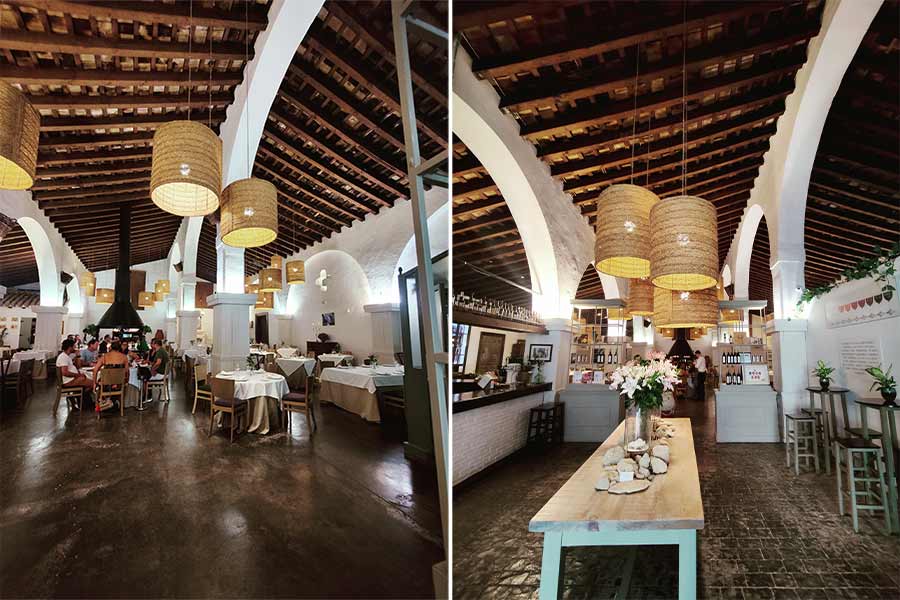
La Carbona in Jerez de Frontera is a restaurant in a repurposed old wine bodega that serves traditional fare Kalpana Sunder
Very often the ambience of a place also enriches the slow meal experience like our meal at the Rio Grande restaurant in Seville, which faces the river and the Torre del Oro military watchtower. We enjoy a similar experience at La Carbona Restaurant in the old town of Jerez de la Frontera, which is an atmospheric, converted wine bodega with high ceilings and an old-world charm. I also sketch the food that I see in my little book that makes me slow down and remember all the little details.
While I look for vegetarian options, my meat eating friends gorge on grilled sardines on skewers cooked on a wood fire, sprinkled with salt and a dash of lime, slow braised oxtail and slices of Iberian ham that comes from livestock fed exclusively on wild black acorns.

Charcoal grilled sardines is a popular local dish Shutterstock
An omnipresent comfort food is of course churros, which is generally had at breakfast or as a snack. These long sticks of golden, deep fried batter are often dipped in thick chocolate, but I love the simple, crisp ones, just dusted with sugar that I have in a local churreria in Cañete de las Torres.
Celebrating local produce
Most Andalusian food is earthy and local, as the region is largely agricultural, and farm to table is the norm. I recognise familiar flavours in espinacas con garbanzos, a hearty stew with chickpeas and spinach flavoured with garlic and cumin, that speaks of Andalusia’s Arabic heritage. l also enjoy migas, which is made from grated hard bread cooked in extra virgin oil with garlic and scrambled with vegetables or meat. The Middle Eastern and north African influences come together in my favourite dish berenjenas con miel — eggplant fritters drizzled with sugarcane molasses — that are crunchy with an exquisite contrast of flavours.
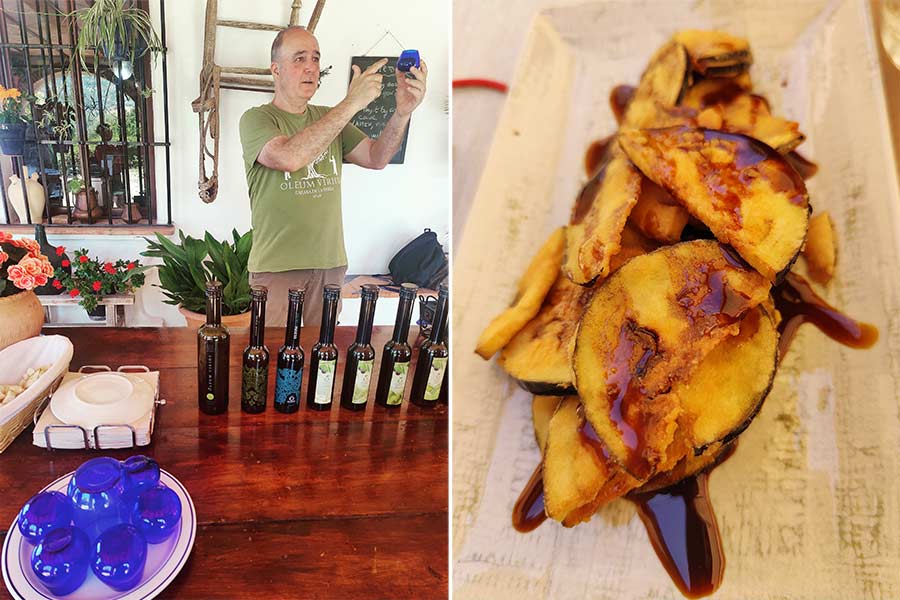
L-R: Olive oil tasting at Oleum Viride; and berenjenas con miel — eggplant fritters with sugarcane molasses Kalpana Sunder
We get used to drizzling extra virgin olive on our breads and salads and look forward to platters of marinated olives with our aperitifs. I fall in love with Inés Rosales’ olive oil torta or Tortas de aceite, thin as papads crispy biscuits which are an emblematic product of Seville. Between savoury and sweet with a touch of anise, these are great as a snack.
Spain being the largest producer and exporter of olive oil in the world, the oil here has its own place in the cuisine. We have an olive oil tasting session at the almazara or oil press Oleum Viride in Zahara de la Sierra, one of the ‘white towns’ of Andalusia. We get an insight on the intensive process of making olive oil from harvest to bottling.
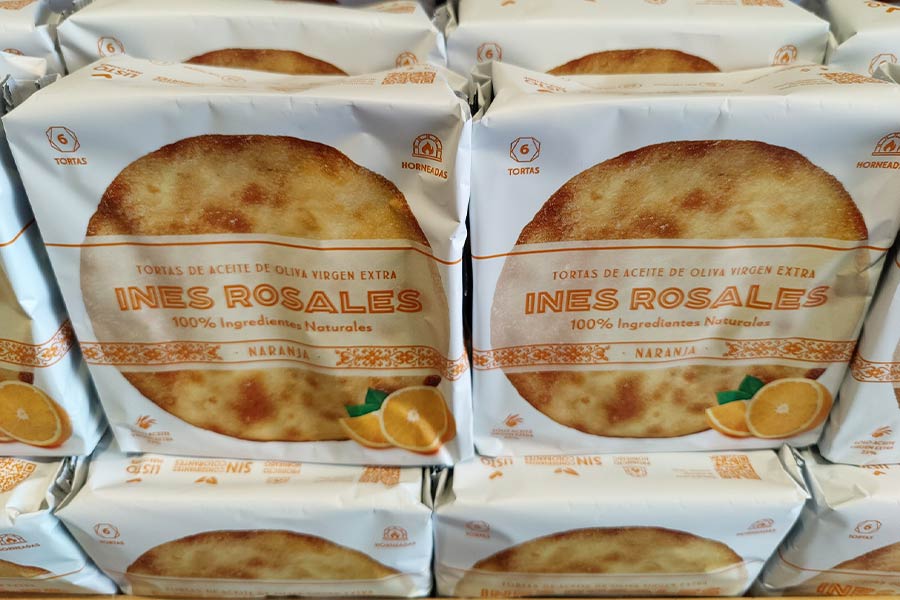
The popular Inés Rosales’ olive oil torta in Seville Kalpana Sunder
At Sensur Gastrobar in Ronda, the town perched on a rocky outcrop, I enjoy a grilled artichoke, the globe shaped flower that is a meal by itself. Spain is the second largest producer of artichokes in the world, and it makes a frequent appearance in its cuisine. Another version I enjoy is artichoke fritters served with aioli, a garlicky mayonnaise sauce.
When it comes to Spanish food, there has to be a mention of paella. Though originally from Valencia, the iconic rice dish is also served throughout Aldalusia and I love the vegetarian version that the chef makes for us at Finca Kukutana, an Andalusian farmhouse outside Seville that serves us a beautiful al fresco meal in the huge garden. Paella, which takes its name from the wide pan in which it is cooked, uses a variety of beans, short grain Bomba rice, saffron, turmeric and seafood or vegetables. Spanish food historian Lourdes March says that the dish “symbolises the union and heritage of two important cultures, the Roman, which gives us the utensil and, the Arab which brought us the basic food of humanity for centuries — rice”.

At Finca Kukutana, the chef shows off his vegetarian paella — the dish with Valencian roots that is popular in Andalusia as well Kalpana Sunder
Sweet surprises
I indulge my sweet tooth with all the desserts that are found in this region. I love natillas, which are sweet custard-like desserts typically made with milk, sugar, eggs, cinnamon, and lemon zest. There is also the tocino de cielo, which is their version of the caramel custard. This traditional Spanish dessert originated in the monasteries in the 19th century.
Another one that wows me in Malaga is the tortas locas, a sweet created with two halves of puff pastry with a custard filling, and orange frosting topped with a cherry. The other big dessert attraction in Andalusia is gelato! Gelato shops all over towns like Malaga and Seville city do brisk business to provide relief from the heat and serve up a multitude of flavours. Along with fried almonds, the other nutty offering found in shops all over is different versions of almond turrón, which is a nougat made with almonds and honey — a dessert that traces its origins to the Moors. During the Christmas season, families and friends gather around tables adorned with an assortment of turróns.

Bakeries with bread and sweet treats are all around Malaga and almost everywhere you will find varieties of turrón Kalpana Sunder
I bring back the tastes and rich experiences of Andalusia back with me in the form of food souvenirs — I carry some turrón, Manchego, bottles of marinated olives and olive oil, sachets of Spanish saffron and red wine home.
